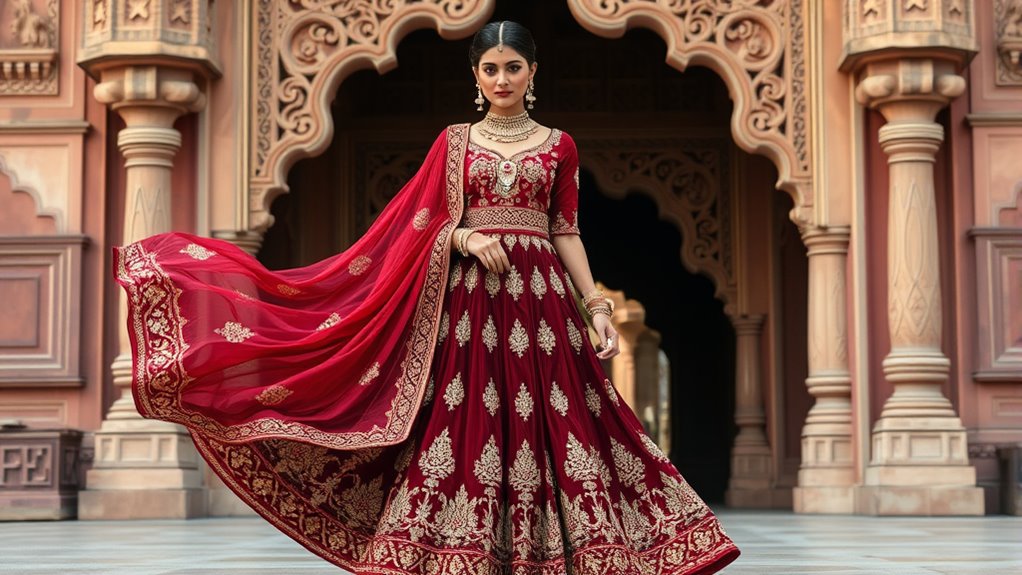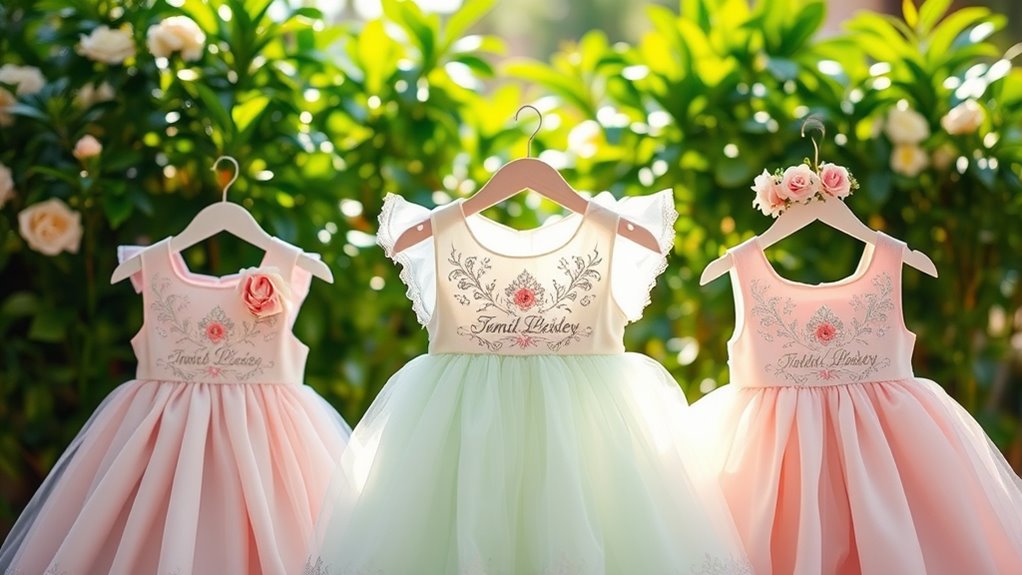
When you think of Rajputi dress for women, you can’t help but admire its historical significance and exquisite craftsmanship. This attire not only showcases vibrant colors and luxurious fabrics but also tells tales of valor and tradition. Each piece is a blend of art and culture, making it a timeless choice for various occasions. So, what makes this attire stand out in today’s fashion landscape? Let’s explore its key elements and unique appeal.
Key Takeaways
- Rajputi dresses are characterized by vibrant colors, rich fabrics like silk and cotton, and intricate embroidery techniques such as Zardozi and Gota Patti.
- Iconic styles include the Anarkali lehenga and Gota Patti lehenga, showcasing elaborate designs and cultural significance.
- Dupattas, made from materials like chiffon and silk, are essential accessories that enhance the overall look of Rajputi attire.
- Traditional Rajputi jewelry, including jhumkas and chokers, complements the dresses and adds an elegant touch to the ensemble.
- Contemporary adaptations incorporate modern fabrics and styles, making Rajputi dresses versatile for various occasions while maintaining traditional elements.
Historical Significance of Rajputi Dress
When you explore the historical significance of Rajputi dress, you’ll discover it reflects the rich cultural heritage of the Rajput community in India. This attire isn’t just clothing; it symbolizes the royal traditions that have shaped the identity of Rajput women for centuries. The vibrant colors, intricate embroidery, and luxurious fabrics showcase the artistic skills passed down through generations. Each piece tells a story of valor, honor, and the status of women within a patriarchal society. By embodying these elements, Rajputi dress connects you to the past, allowing you to appreciate the elegance and dignity that define the Rajput legacy. Understanding this significance enriches your appreciation for the attire and its role in preserving cultural identity.
Key Elements of Rajputi Attire
When you think about Rajputi attire, several key elements come to mind. Traditional fabrics and intricate embroidery play a significant role in showcasing the elegance of this style, while unique accessories and jewelry complete the look. Let’s explore how these components come together to define the beauty of Rajputi dress.
Traditional Fabrics and Textiles
Traditional fabrics and textiles play an essential role in defining Rajputi attire, showcasing the rich cultural heritage of Rajasthan. You’ll find that traditional weaving techniques, passed down through generations, create stunning fabrics like silk, cotton, and georgette. Each material brings its unique charm, enhancing the elegance of your outfit. As you explore, you’ll notice regional variations in textile designs and colors, reflecting the diverse influences of Rajasthan’s different areas. For instance, the vibrant Bandhani and the intricate Leheriya are popular in certain regions, offering a distinctive flair to your wardrobe. By embracing these textiles, you’re not just wearing a dress; you’re celebrating a rich tapestry of history and craftsmanship that defines Rajputi culture.
Intricate Embroidery and Patterns
Intricate embroidery and patterns serve as the heart of Rajputi attire, bringing vibrancy and life to each piece. You’ll find that these designs reflect rich cultural influences and regional variations, making each garment unique. The delicate craftsmanship showcases the skills of artisans who pour their creativity into every stitch.
| Embroidery Type | Description |
|---|---|
| Zardozi | Metallic thread work, often with gold or silver. |
| Gota Patti | Use of gold and silver lace, creating stunning motifs. |
| Resham Work | Vibrant silk thread embroidery in intricate patterns. |
| Kantha | Hand-stitched patterns, often with motifs from nature. |
| Mirror Work | Small mirrors sewn into the fabric for a dazzling effect. |
These elements not only enhance the beauty of the attire but also tell stories of tradition and heritage.
Unique Accessories and Jewelry
While the embroidery and patterns of Rajputi attire captivate the eye, the unique accessories and jewelry elevate the ensemble to a whole new level. You can’t underestimate the power of traditional jewelry in completing your look. Pieces like intricate necklaces, heavy bangles, and nose rings add an authentic touch that reflects the rich heritage of Rajput culture. Statement accessories, such as embellished maang tikka and jhumkas, draw attention and create a stunning focal point. Don’t shy away from bold colors and intricate designs; they’re essential for that regal appearance. As you adorn yourself, remember that these carefully chosen accessories not only enhance your outfit but also tell a story of tradition and elegance that’s uniquely yours.
Popular Fabrics Used in Rajputi Dresses
Rajputi dresses are renowned for their vibrant colors and rich textures, largely thanks to the diverse fabrics that bring them to life. You’ll find a variety of fabric types, including silk, cotton, and chiffon, each contributing to the elegance of Rajputi designs. These fabrics reflect cultural influences and regional variations, ensuring that every piece tells a unique story. Seasonal adaptations also play a role; lighter fabrics are preferred in summer, while heavier ones grace the winter months. As fashion trends evolve, traditional materials are often blended with modern textiles, creating stunning color palettes that captivate the eye. Artisan craftsmanship is at the heart of these creations, making each dress a beautiful amalgamation of heritage and contemporary style.
Traditional Embroidery Techniques
When you explore Rajputi dresses, you’ll find that traditional embroidery techniques play an essential role in their charm. Zardozi work, mirror embellishments, and Kantha stitch traditions each add unique flair and richness to these garments. Understanding these techniques will enhance your appreciation for the artistry behind Rajputi attire.
Zardozi Work Techniques
Zardozi work techniques represent a rich tradition of embroidery that has captivated artisans and fashion enthusiasts alike. Originating from Persian influence, Zardozi history reveals intricate craftsmanship using metallic threads, giving garments a regal touch. When you explore Zardozi techniques, you’ll notice how they incorporate unique Zardozi patterns that enhance the beauty of Rajputi dresses. Artisans skillfully use various Zardozi materials like gold and silver threads, along with silk and velvet fabrics, to create stunning designs. The versatility of Zardozi applications allows it to adorn sarees, lehengas, and even accessories. With modern Zardozi innovations, you’ll find fresh designs that maintain tradition while appealing to contemporary tastes, ensuring this exquisite art form remains relevant in today’s fashion landscape.
Mirror Work Embellishments
Building on the intricate beauty of Zardozi work, mirror work embellishments offer another layer of elegance to traditional attire. You’ll find that mirror work techniques involve sewing small, reflective pieces of glass onto fabric, creating a stunning visual effect that catches the light beautifully. This art form has a rich mirror work history, tracing back to the royal courts of Rajasthan, where it was used to enhance the opulence of garments. When you wear Rajputi dresses adorned with mirror work, you embrace a piece of cultural heritage that speaks to the artistry and craftsmanship of the region. These embellishments not only enhance your outfit but also tell a story of tradition, making your ensemble truly unique.
Kantha Stitch Traditions
Although often overshadowed by other intricate embroidery techniques, Kantha stitch traditions hold a special place in the domain of traditional Indian craftsmanship. You’ll find that Kantha techniques are not just about stitching; they tell stories through vibrant Kantha motifs, transforming simple fabrics into works of art.
Here are some key features that make Kantha stitching unique:
- Recycled Fabrics: Utilizes old sarees and cloths, promoting sustainability.
- Versatile Motifs: Features nature-inspired designs like flowers, birds, and geometric patterns.
- Layering: Employs multiple layers of fabric for depth and texture.
- Handcrafted: Each piece is uniquely crafted by skilled artisans.
- Cultural Significance: Represents the rich heritage of Bengal and its artistic expression.
Embrace the beauty of Kantha in your Rajputi attire!
Iconic Styles of Rajputi Lehengas
When you think of traditional Indian attire, the Rajputi lehenga immediately stands out with its regal charm and intricate craftsmanship. These lehengas showcase stunning embroidery, vibrant colors, and luxurious fabrics that reflect the rich cultural symbolism of Rajasthan’s royal heritage. You’ll find styles like the Anarkali lehenga, known for its flared silhouette, and the Gota Patti lehenga, which features shimmering embellishments that catch the light beautifully. Each piece tells a story, often adorned with motifs that celebrate nature and history. Whether you’re attending a wedding or a festive occasion, wearing a Rajputi lehenga allows you to embrace tradition while showcasing your unique style. It’s a timeless choice that combines elegance with the essence of Rajputi craftsmanship.
The Role of Dupattas in Rajputi Fashion
Dupattas play an essential role in Rajputi fashion, serving as both a statement piece and a symbol of tradition. Their significance extends beyond mere adornment, as they reflect cultural heritage and personal style. When you explore dupattas styles, you’ll discover a variety that enhances your ensemble beautifully:
- Chiffon Dupattas: Lightweight and flowing, perfect for warm climates.
- Silk Dupattas: Luxurious and rich, ideal for festive occasions.
- Embroidered Dupattas: Intricate designs add a touch of elegance.
- Net Dupattas: Sheer and stylish, offering a contemporary flair.
- Bandhani Dupattas: Traditional tie-dye patterns that showcase regional artistry.
Each style contributes to the overall aesthetic, making your Rajputi dress even more enchanting. Embrace the versatility and charm of dupattas to elevate your look!
Jewelry and Accessories Complementing Rajputi Dress
To complete your Rajputi look, pairing the right jewelry and accessories is a must. Opt for traditional Rajputi jewelry like jhumkas, chokers, and intricate bangles that enhance your outfit’s elegance. Consider statement pieces that reflect current Rajputi dress trends while celebrating the rich Rajputi fashion evolution. When choosing Rajputi accessories, don’t forget to include embellished maang tikka and colorful potli bags that complement your dress colors and styles. These additions not only elevate your appearance but also suit various Rajputi dress occasions, from weddings to festivals. Remember, proper Rajputi dress care guarantees your attire and accessories remain vibrant and stunning. So, embrace these elements to truly shine in your Rajputi ensemble!
Contemporary Adaptations of Rajputi Fashion
When it comes to contemporary adaptations of Rajputi fashion, you’ll notice a fascinating blend of traditional elements with modern fabrics and techniques. Designers are creatively fusing these classic styles with Western influences, making them more accessible for today’s women. You’ll find that this evolution maintains the essence of Rajputi culture while embracing innovation.
Modern Fabrics and Techniques
While traditional Rajputi dresses are celebrated for their rich fabrics and intricate craftsmanship, modern adaptations have transformed these garments by incorporating contemporary materials and innovative techniques. You’ll find that today’s Rajputi fashion embraces sustainable fashion practices and fabric innovations, guaranteeing you can wear these stunning outfits with a sense of responsibility.
Here are some modern elements you might encounter:
- Eco-friendly fabrics: Organic cotton, bamboo, and hemp
- Digital printing: Allows for vibrant, intricate designs
- Lightweight materials: Guarantees comfort without compromising style
- Versatile silhouettes: Adaptable for various occasions
- Innovative embellishments: Using 3D printing and laser-cut techniques
These adaptations not only honor tradition but also push the boundaries of Rajputi fashion into the future.
Fusion With Western Styles
The evolution of Rajputi fashion has led to exciting fusions with Western styles, creating a unique blend that appeals to a broader audience. You’ll find traditional elements like intricate embroidery and vibrant colors combined with modern silhouettes that enhance comfort and style. Think of a classic lehenga paired with a chic crop top or a saree draped over tailored pants. This cultural fusion not only showcases the rich heritage of Rajputi attire but also makes it relevant for contemporary wardrobes. Designers are pushing boundaries, allowing you to express your individuality while honoring tradition. Embrace this fusion by experimenting with accessories and styling techniques that reflect both cultures, making your outfit a statement of elegance and modernity.
Styling Tips for Wearing Rajputi Dress Today
Although you might think of the Rajputi dress as a traditional outfit, it can easily be styled for modern occasions. Here are some tips to help you incorporate this beautiful garment into your wardrobe:
- Play with color combinations: Opt for vibrant hues or pastel shades to match your personality.
- Mix textures: Pair your Rajputi dress with a denim jacket or leather accessories for a contemporary twist.
- Choose the right footwear: Go for stylish juttis or modern heels to elevate your look.
- Accessorize wisely: Use statement jewelry that complements the intricate designs of your dress without overpowering it.
- Experiment with silhouettes: Try a layered approach or belt your dress for a chic, tailored appearance.
With these tips, you’ll nail event styling while honoring tradition!
Celebrating Festivals and Occasions in Rajputi Attire
When you celebrate festivals and special occasions, donning a Rajputi dress not only showcases your appreciation for tradition but also adds a touch of elegance to your festivities. The vibrant colors and intricate embroidery of Rajputi attire reflect its cultural significance, reminding you of the rich heritage of Rajasthan. Whether it’s Diwali, Teej, or a wedding, wearing a Rajputi dress connects you to the joyous spirit of festive celebrations. You can pair it with traditional jewelry and accessories to enhance your look. The flowing silhouette and beautiful fabrics allow you to move gracefully while embracing the essence of the occasion. So, next time you join in the celebrations, let your Rajputi attire be a symbol of your pride in cultural traditions.




